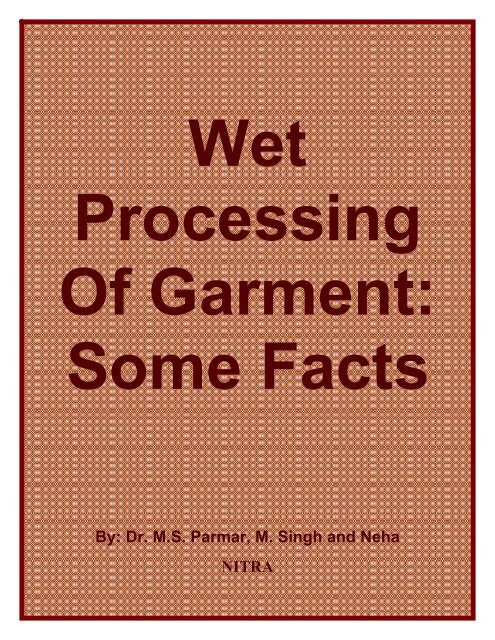By: Dr. M.S. Parmar, M. Singh and Neha NITRA - Fibre2fashion
By: Dr. M.S. Parmar, M. Singh and Neha NITRA - Fibre2fashion
By: Dr. M.S. Parmar, M. Singh and Neha NITRA - Fibre2fashion
Create successful ePaper yourself
Turn your PDF publications into a flip-book with our unique Google optimized e-Paper software.
Wet<br />
Processing<br />
Of Garment:<br />
Some Facts<br />
<strong>By</strong>: <strong>Dr</strong>. M.S. <strong>Parmar</strong>, M. <strong>Singh</strong> <strong>and</strong> <strong>Neha</strong><br />
<strong>NITRA</strong>
Wet Processing Of Garment: Some Facts<br />
<strong>By</strong>: <strong>Dr</strong>. M.S.<strong>Parmar</strong>, M. <strong>Singh</strong> <strong>and</strong> <strong>Neha</strong><br />
Northern India Textile Research Association, Sector-23, Rajnagar, Ghaziabad, U.P<br />
Garment dyeing is gaining ground more rapidly as it fulfills the requirement of fashion-oriented<br />
customer instantaneously. Beside this it reduces the lead times <strong>and</strong> excess inventory<br />
significantly. In addition, it can be used as a method for short lot dyeing, where basic shades are<br />
supplemented with fashion shades.<br />
In India most of the Garment industries is in unorganized sector. This sector is far behind the<br />
international st<strong>and</strong>ards in productivity <strong>and</strong> quality. The important reasons of legging behind of this<br />
sector are listed below:<br />
1. Non- availability of qualified <strong>and</strong> trained operators/supervisors<br />
2. Absence of quality control activities<br />
3. Application of sub st<strong>and</strong>ard dyes <strong>and</strong> chemical auxiliaries<br />
4. Lack of sophistication in the technology used in wet processing<br />
Non- availability of qualified <strong>and</strong> trained operators/supervisors:<br />
The problem related to non-availability of qualified <strong>and</strong> trained operators/ supervisors can be by<br />
resolved by recruiting suitable personnel. Keeping in mind the requirement of garment wet<br />
processors, <strong>NITRA</strong> has started a full time diploma course in garment dyeing <strong>and</strong> finishing. The<br />
Diploma holders are fully trained in garment wet processing.<br />
Absence of quality control activities:<br />
The absence of proper quality control in-house activities is the main reason, which affect the<br />
quality of the dyed <strong>and</strong> finished garment. Now the buyer is very quality conscious. To fulfill the<br />
quality requirement of the buyer it requires adopting stringent quality control st<strong>and</strong>ard in the<br />
dyeing <strong>and</strong> finishing. A few of the quality parameters/ problems which generally affect the quality<br />
of the buyer/ user ends are poor colour fastness properties in various agencies like washing, light,<br />
crocking etc., staining, tendering, yellowness <strong>and</strong> improper finishing effect. These problems may<br />
lead to rejection of whole lot. To check these problems following points should be taken in to<br />
accounts:<br />
• Carefully read the instruction given by the buyers related to quality parameters <strong>and</strong><br />
st<strong>and</strong>ard to be followed i.e whether it is American st<strong>and</strong>ard or ISO st<strong>and</strong>ards etc. If there<br />
is no clear instruction it is always better to clarify the same before going to take<br />
assignment. Each st<strong>and</strong>ard is having its separate conditions. If sample is passed in one<br />
st<strong>and</strong>ard, it is not sure that it will also pass in another st<strong>and</strong>ards also.<br />
• During the desizing operation of the garments, it is always advised to check whether the<br />
sizing chemicals removed from the garment or not. A simple iodine test will be sufficient<br />
for this purpose. If the blue colour with iodine is indicated, it shows that sizing material is<br />
still present <strong>and</strong> desizing of the garment is not proper.<br />
• Check the absorbency of the garment before dyeing. If the absorbency of the garment is<br />
not proper, no uniform shade is obtained. A simple method to test the absorbency is to<br />
take out garment before few minutes of completion of scouring process, dry it <strong>and</strong> test<br />
the absorbency by drop test method. If the drop of water is absorbed within 5 seconds,<br />
one can say that the garment absorbency would be fine.
• After pretreatment, before dyeing, dyer should be sure that garment is having neutral pH.<br />
This can be checked by pH paper.<br />
• Before dyeing, it is advisable to test the hardness of water. If the water hardness is very<br />
high it may hinder uniform dyeing of the garment. Now-a- days a simple kit is available to<br />
do testing of hardness of water. Generally the water hardness should be 0 to 5 ppm. If it<br />
is high, sequestering agent may be used.<br />
• Proper class of dyes should be selected as per the instruction of buyers <strong>and</strong> before going<br />
to dyeing operation, Garment dyers should read carefully the shade card of dyes to know<br />
the fastness properties of the dye <strong>and</strong> the dyeing instructions.<br />
• It has been seen that some time Garment dyers not washed/neutralized the garment<br />
properly after dyeing to save time <strong>and</strong> money. Avoiding this essential step some time<br />
create big problem among the fabric supplier, dyer <strong>and</strong> the buyer. If the fabric is not<br />
properly neutralized, it may have acidic or alkaline pH. If the fabric is having acidic pH, it<br />
may react with metal part of the button <strong>and</strong> may produce stains. Improper<br />
washing/neutralization some time produces tendering (degradation of fabric strength)<br />
effect in the garment.<br />
Application of sub st<strong>and</strong>ard dyes <strong>and</strong> chemical auxiliaries:<br />
The use of subst<strong>and</strong>ard dyes <strong>and</strong> chemical auxiliaries affect quality of garment adversely. Here<br />
also the good quality control activities can check this problem. This will not only improve upon<br />
quality but also impose proper check on the dyes <strong>and</strong> chemical auxiliaries supplier.<br />
Lack of sophistication in the technology used in wet processing:<br />
In India very old technologies are being used for wet processing of garments. Due to old<br />
technology garment processors are not getting production as per the international st<strong>and</strong>ards.<br />
Beside these buyers now wants more functions in the garments, which is not possible in the old<br />
wet processing technologies. Another draw back of old technology is that it uses huge quantity of<br />
water to process the garments. The availability of water require for wet processing is reducing<br />
day by day. If the water consumption is high in the wet processing, it will generate more effluent.<br />
Now pollution boards have set stringent norms for releasing effluent in the drain. Due to this the<br />
treatment cost of the effluent will be more.<br />
With the rapid change in international scenario, it is the need of today to go for technology<br />
advancement in the garment dyeing <strong>and</strong> finishing. Now the buyer may wants different functions in<br />
the garments, which may not be fulfilled by the single machine. Therefore it is the requirement to<br />
have machines, which can perform various functions <strong>and</strong> integrated with information technology<br />
to deliver higher production at lower cost. A few of the new development in the in the garment<br />
dyeing machine are given below:<br />
• Facility to operate ambient temperature to 135 o C so polyester blended garments can also<br />
be dyed in such type of machines.<br />
• Incorporated with hydro-extraction device<br />
• Reduce water consumption<br />
• Excellent energy saving capacity<br />
• Automatic electro pneumatic balancing with total vibration absorption, which means that<br />
foundations are not required<br />
• Microprocessor based operating system to better control on process parameters
• Variable drum speed starting 1 rpm to the maximum inverter regulated spin speed<br />
• Very fast operation <strong>and</strong> no feed for h<strong>and</strong>ling during the garment-unloading phase<br />
• Possibility of applying easy <strong>and</strong> economic automation <strong>and</strong> robotic function during<br />
loading/unloading stage<br />
• Very fast loading times<br />
Innovation in Garment finishing:<br />
There are numerous reasons to add value to a product. The most obvious are to revitalize sales,<br />
achieve a premium price <strong>and</strong> differentiate the product from the plethora of others in the market.<br />
Less obvious but equally as important—retailers <strong>and</strong> leading br<strong>and</strong> labels see unique products as<br />
one of the best ways to exp<strong>and</strong> <strong>and</strong> diversify their line.<br />
The development of unique fabric <strong>and</strong> garment finishes comes with a host of challenges. Finishes<br />
must be durable during the fabric finishing process; stable in the presence of other chemicals;<br />
wash-fast <strong>and</strong> evenly <strong>and</strong> consistently applied. Finishes also need to be financially feasible <strong>and</strong><br />
environmentally friendly.<br />
Micro encapsulation is one of the latest technologies used to impart an array of unique<br />
characteristics to a garment. Particles filled with active ingredients are applied to the fabric or<br />
garments for long lasting effects.<br />
Micro encapsulated particles are anchored onto the fiber. As the wearer moves, the capsules are<br />
activated producing a slow release of the active ingredient. Active ingredients run the gamut<br />
including moisturizers, aloe, vitamin E, therapeutic smells <strong>and</strong> insect repellent.<br />
Recent development on creating fading effect on denim garment by Ozone is in progress. In this<br />
method only ozone gas is used for fading denim thus paving the way of saving huge amount of<br />
water <strong>and</strong> energy utilized in the conventional denim finishing/fading operations.<br />
About the author:<br />
<strong>Dr</strong>. M. S. <strong>Parmar</strong> is presently heading two Departments - Research &<br />
Product development <strong>and</strong> Chemical Quality Evaluation Divisions. He has 16<br />
years experience in Chemical Processing <strong>and</strong> Quality Control of textiles <strong>and</strong><br />
garments. He has worked on various R&D projects related to chemical<br />
processing, Denim processing, Hosiery, Enzymatic processing, Natural<br />
coloured cotton, Organic cotton, Milkweed fibres etc.<br />
He is a co-Author of a Book on Denim <strong>and</strong> authored two books, one in<br />
dyeing, printing <strong>and</strong> finishing <strong>and</strong> other in Knitting. His 40 Papers are<br />
published in various National <strong>and</strong> International Journals <strong>and</strong> presented 30 papers in conferences.<br />
<strong>Neha</strong> Sharma has received her Master’s Degree in Textiles & Clothing from<br />
Delhi University. She had worked as a lecturer in a Post Graduate College at<br />
ModiNagar. Presently working as a Research Associate, looking after<br />
activities of Garment Dyeing <strong>Dr</strong>y-Cleaning & Finishing Technology program.<br />
Beside this also involved in various courses offered by Northern India Textile<br />
& Research Association. She has jointly prepared series of booklets<br />
(TABLETS) on various topics like care labeling, zippers, sewing of knits,<br />
stains, quality assurance in apparel manufacturing etc .She has credit no. of<br />
published papers in various journals/magazines.<br />
Source: <strong>NITRA</strong> Email : nitra@vsnl.com
To read more articles on Textile, Fashion, Apparel, Technology, Retail <strong>and</strong> General please<br />
visit www.fibre2fashion.com/industry-article<br />
To promote your company, product <strong>and</strong> services via promotional article, follow this link:<br />
http://www.fibre2fashion.com/services/featrued-article/featured_article.asp

















